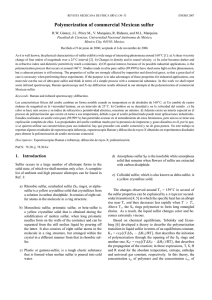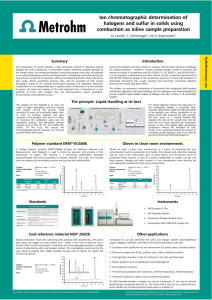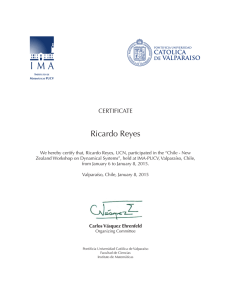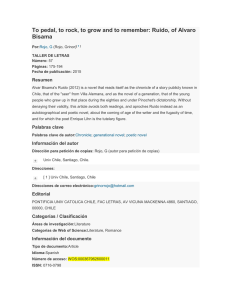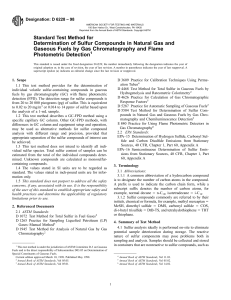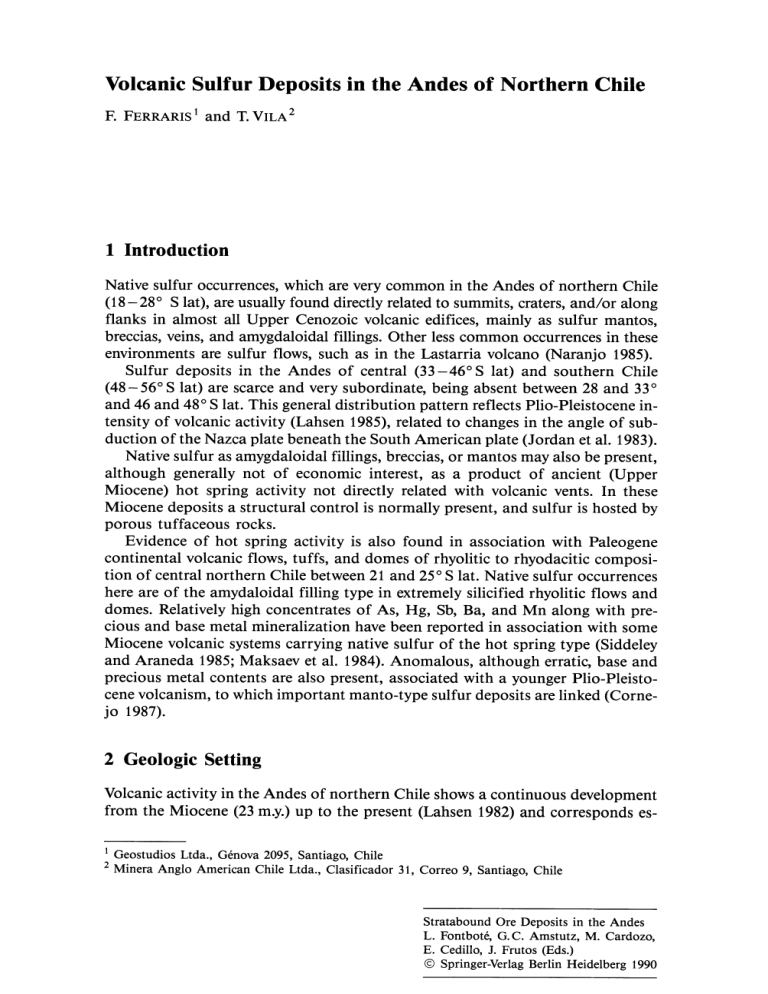
Volcanic Sulfur Deposits in the Andes of Northern Chile F. FERRARIS 1 and T. VILA 2 1 Introduction Native sulfur occurrences, which are very common in the Andes of northern Chile (18-28° Slat), are usually found directly related to summits, craters, and/or along flanks in almost all Upper Cenozoic volcanic edifices, mainly as sulfur mantos, breccias, veins, and amygdaloidal fillings. Other less common occurrences in these environments are sulfur flows, such as in the Lastarria volcano (Naranjo 1985). Sulfur deposits in the Andes of central (33 -46° S lat) and southern Chile (48- 56° S lat) are scarce and very subordinate, being absent between 28 and 33 o and 46 and 48° Slat. This general distribution pattern reflects Plio-Pleistocene intensity of volcanic activity (Lahsen 1985), related to changes in the angle of subduction of the Nazca plate beneath the South American plate (Jordan et al. 1983). Native sulfur as amygdaloidal fillings, breccias, or mantos may also be present, although generally not of economic interest, as a product of ancient (Upper Miocene) hot spring activity not directly related with volcanic vents. In these Miocene deposits a structural control is normally present, and sulfur is hosted by porous tuffaceous rocks. Evidence of hot spring activity is also found in association with Paleogene continental volcanic flows, tuffs, and domes of rhyolitic to rhyodacitic composition of central northern Chile between 21 and 25° Slat. Native sulfur occurrences here are of the amydaloidal filling type in extremely silicified rhyolitic flows and domes. Relatively high concentrates of As, Hg, Sb, Ba, and Mn along with precious and base metal mineralization have been reported in association with some Miocene volcanic systems carrying native sulfur of the hot spring type (Siddeley and Araneda 1985; Maksaev et al. 1984). Anomalous, although erratic, base and precious metal contents are also present, associated with a younger Plio-Pleistocene volcanism, to which important manto-type sulfur deposits are linked (Cornejo 1987). 2 Geologic Setting Volcanic activity in the Andes of northern Chile shows a continuous development from the Miocene (23 m.y.) up to the present (Lahsen 1982) and corresponds es1 2 Geostudios Ltda., Genova 2095, Santiago, Chile Minera Anglo American Chile Ltda., Clasificador 31, Correo 9, Santiago, Chile Stratabound Ore Deposits in the Andes L. Fontbote, G. C. Amstutz, M. Cardozo, E. Cedillo, J. Frutos (Eds.) © Springer-Verlag Berlin Heidelberg 1990 692 F. Ferraris and T. Vila sentially to two episodes overlapping in time and space: large volumes of ignimbrite sheets of rhyolitic to dacitic composition and volcanic to volcanoclastic rocks of mainly dacitic to andesitic composition (Gardeweg et al. 1984; Cornejo 1987), giving rise to composite strato-volcanoes that crown the Andean Range above 6000 m.a.s.l. Although Plio-Pleistocene volcanic activity was very intense, represented by more than 470 volcanoes in the area, only 17 remain active at present with fumarolic emanations (Ruiz 1965; Gonzalez 1972; Lahsen 1976), and only six have shown igneous activity in historical records (Bruggen 1950). Older volcanic rocks, mainly andesites and · rhyolites of Paleogene age (41-66 m.y.) are exposed in central northern Chile, representing remnants of an ancient volcanic chain of active continental margin (Fig. 1). Host rocks comprising lavas, tuffs, breccias, and/or ashes with up to 700fo porosity, are intensively altered and leached. 2.1 General Description of Deposits According to their geometry, sulfur deposits can be classified in four main categories (De Wijs, unpubl. report 1943): mantos, breccias, vein filling, and/or stockworks and amygdaloidal fillings (Figs. 2, 3). The most common and important deposits from an economic viewpoint are those of the manto type, that correspond to relatively shallow, homogeneous, and continuous sulfur lenses of variable thickness (0.5- 20 m), exposed generally in conformity with the surficial volcanic flows. Manto deposits, as subhorizontal to 35° dipping lenses, are concentrated, on the concave portions of volcanic flanks, where they can reach 1 km2 in extension. Sulfur here is deposited in the microscopic to submicroscopic pores of highly porous tuffaceous host rocks (Fig. 4). A 0.5- to 5-m-thick barren (5% -25% S) overburden or "costra", composed of volcanic ashes and debris, generally covers the sulfur caliche lenses (50%- 80% S), although the limit between them is not always well defined, with a progressive decrease in S towards the upper costra zones. In some volcanoes (Theora, Ollague), two or more sulfur mantos may be present interlayered with barren or low S grade units. Sulfur breccias may occur either as relatively small, pipe-like bodies emplaced as crater or volcanic vent fillings or as irregularly shaped subhorizontal bodies. In both cases, native sulfur cements angular volcanic fragments of variable size. Copper sulfides, dominantly covellite, have been reported within a sulfur breccia in a volcanic vent at the Aucanquilcha deposit (Ruiz 1965; Clark 1970). This unusual association is of hypogene origin and it appears to have formed essentially in the same period during post-volcanic hydrothermal activity (Clark 1970). Vein filling corresponds to single or multiple bright yellow to orange, massive, subtranslucent sulfur veins that fill random cracks and fissures, criss-crossing sulfur mantos and/or bleached barren volcanics. Sulfur veins are generally subvertical, narrow (less than 1 m) and do not exceed 50 m in length, with anastomosing shapes. As sulfur veins and veinlets increase in density, a sulfur stockwork is developed, generally present at the bottom of manto type deposits. Sulfur grade in vein fillings is normally higher than 70%. 693 Volcanic Sulfur Deposits in the Andes of Northern Chile 0 ~ ~~c~~·.~~~~::~~ 11g!~0 ~~nf~~~i~~') g ;:~oyc~~~~~~~b5~itts intt rbtddtd with udimtn- [[IIJ ~~~~~~rr.· j~~~~~!i~a':4o:'f,~'it~::r:.•n·,:rj~~~i!" mentor~ StQutr~cu '---1=--+-----c:~--' ~ Mloctl"lt volcanic bflt 0 Au-Ao (Cu) tpitl'ltrmol dtposif Porphyry copptr dtpos it Sulfur dtposit Fig. 1. General distribution of sulfur deposits in northern Chile. Geologic framework after Gardeweg et a!. (1984) F. Ferraris and T. Vila 694 VOLCAN IC CRATER FRAGMENTAL LANOSLIOE ANOESITIC - OACITIC STRATifiED L AYERS Enlarged zone in Fig. 3 UNALTERED ROCKS v v Fig. 2. Generalized sections showing relationship between different native sulfur occurrences with geologic structures and hydrothermal alteration (after De Wijs, unpubl report 1943) Amygdaloidal fillings occur mainly as sulfur nodules of variable size (0.01 - 0.5 m), associated with fumarolic vents or with hot spring activity. They also may be present related with several other sulfur occurrences, although not of economic interest. Sulfur associated with hot spring activity, as amygdaloidal and/or vein fillings, may be accompanied by disseminated pyrite. An uncommon sulfur occurrence is represented by sulfur flows, such as in the Lastarria volcano (Naranjo 1985). Here, two main 10-20-cm-thick sulfur flows of 220 to 350m in length occur in the northwestern flank of the volcano interstratified with a pyroclastic flow. Sulfur flows range in color from pale greenish yellow near the source to gray at the distal ends, showing pahoehoe structure and surface textures. These flows appear to have been formed by melting of previous fumarolic sulfur deposits caused by a heat rise due to reactivation of volcanic activity (Naranjo 1985). According to the color and concentration of S, two main caliche types can be distinguished: the most common corresponds to a bright yellow to orange, powdery aggregate, with S ranging from 450Jo to 75%; a subordinate type is represented by a dark red-brown to grayish material, locally called negrillo, with 80%-95% S, normally present at the base of the manto deposits (Vila 1953) or in the inner part of fracture filling and vents (Naranjo 1985). Retained color differences are probably due to distinct temperatures of formation (Meyer 1976). The yellow orange, brittle crystalline sulfur aggregate is evidently the result of sublimation processes taking place between the boiling point Volcanic Sulfur Deposits in the Andes of Northern Chile LEACHED ROCK . POROUS , 695 STRONG SILICIFIED-CHALCEDONIC SEAMS AND POCKETS OF NAT IVE SULFUR, ALUNITE ANO GYPSUM. 30 - 70 "'o SULFUR MANTO ( HIGHER ORIGINAL POROSITY?). NORMALLY SULFUR GRADE INCREASES WITH DEPHT (80%) . LOCAL 81- v GASEOUS HaS AT DI;PHT ~L tOm. v v ~SUB VER:AL FILLED FRACTURES WI TH VITREOUS, TRANSLUCENT, WELL CRYSTALLIZED SULFUR. Fig. 3. Enlarged zone indicated in Fig. 2 showing some details of manto, amygdaloidal, and fracturefilling sulfur occurrences Fig. 4. Remnants of stratabound sulfur mantos on highly porous tuffaceous rocks 696 F. Ferraris and T. Vila of water (83- 84 °C at this altitude) and the melting point of sulfur (113 °C), while red-brown to black sulfur is formed probably above 250 °C. The dark color is due to inclusions of organic bituminous matter. Other elements that normally accompany sulfur deposits are As (0.10o/o -0.002%), together with traces of Sb (less than 15 ppm), Se (less than 30ppm), and Th (less than 20ppm). Available analytical data also show a general increase of As with diminishing grade of sulfur ore. Early isotopic analyses were published by Amstutz (1959). 2.2 Hydrothermal Alteration All sulfur occurrences are associated with very intense hydrothermal alteration of the acid-sulfate type (Heald et al. 1967) and bleaching of the host rocks, conforming "color anomalies" that can be seen from many kilometers away. Hydrothermal alteration produced in this high sulfidation environment is originated by heated, extremely acid fumarolic emanations (mainly water steam with dissolved C02 and H 2S) that destroy the original feldspars and ferromagnesian minerals, transforming the rock into a highly porous, white to light grayish amorphous or cryptocrystalline silica aggregate (Fig. 4). The oxidation of H 2S reacting with the removed AI, Mg, Na, or K produces several sulfates, mainly gypsum and alunite, deposited at short distances from or even within sulfur deposits. White clays (kaolinite) are also often produced by feldspar alteration. Field evidence suggests that hydrothermal alteration slightly precedes or is contemporaneous with sulfur deposition. 2.3 Genesis Sulfur transport and deposition is controlled both by chemical and physical processes, although the shape of primary volcanic deposits appears to be highly dependent on physical characteristics (porosity). Field evidence clearly demonstrates that in general sulfur was, and is presently being deposited, filling voids and microfractures in the rock as sublimates from the rapid cooling of H 2S-rich steam in the proximities to volcanic vents. Primary sulfur deposition from a dominantly molten stage is unlikely, considering the bright yellow color of sulfur, characteristic of lower (up to 113 °C) temperatures (Meyer 1976). The extremely pure (70% -90% ), massive, subtranslucent yellow native sulfur present as vertical, vein-like fracture fillings superimposed over manto deposits, suggests a downward migration of previously deposited sublimates, originated by intermittent increase in the thermal gradient. Chemically, sulfur deposition may be generated by partial oxidation of H 2S by atmospheric oxygen and/or by oxygen dissolved in groundwaters. This last mechanis~ places a depth constraint to which a deposit may extend. From the above, it follows that there are at least two requisites for the genesis of sulfur deposits: Volcanic Sulfur Deposits in the Andes of Northern Chile 697 a) A favorable, highly porous and permeable host rock. This feature is provided by the strongly altered and bleached tuffs and lava flows, generating thus the common manto-type deposit. b) Atmospheric oxygen. Sulfur deposition is then restricted to a shallow zone where oxygen is available, between surface and, probably, the deepest zone of meteoric groundwater infiltration. 3 Short Description of Two Selected Native Sulfur Deposits 1\vo representative Andean native sulfur deposits were selected for a short description: the Plio-Pleistocene Tacora volcano deposits, near the Peruvian border, and the more deeply eroded Miocene (19.2±3.9 m.y.; Cornejo 1987) Gorbea volcano deposit, in the central part of the sulfur belt (Fig. 1). The Tacora volcano appears to have one of the largest sulfur reserves in Chile. Relatively thick (2-6m) sulfur caliche mantos covering areas of 0.2-0.3 km2 are located between 4300 and 5700 m altitude, along the northern and eastern flanks, as well as in the crater beneath a thin barren volcanic ash overburden. Sulfur intermixed with volcanic ashes is mainly cementing volcanic debris, that include angular fragments of variable size of altered andesites, basalts, and volcanic breccias. At the NW flank of the volcano, three stacked 1- to 6-m-thick sulfur mantos occur interlayered with barren, gray, slightly consolidated volcanic ashes (Vila 1953). Sulfur color changes from bright yellow in the upper manto (60<1/o S) to dark brown in the lower one (75%-85<1/o S), showing very low contents of As and Fig. 5. Extinct geyseritic vents 698 F. Ferraris and T. Vila Sb. Gypsum nodules with a crystallized native S nucleus are common in the lower manto (Vila 1953). Fumarolic activity is common, especially in the uppermost eastern flank, represented by emanations of steam, C02 , and H 2S, with crystallized native sulfur being actively deposited on the walls of the fumarolic conduits. Evidence of ancient geyser activity corresponds to groups of geyseritic subsymmetric cones, up to 1.5 m high and 1m in diameter, formed by an extremely hard, rugged amorphous mass of gray opaline silica, intermixed with travertine and gypsum (Fig. 5). At the Gorbea volcano (5200 m.a.s.l.), sulfur occurrences (500Jo- 60% S) correspond mainly to 2-6-m-thick stratabound mantos selectively emplaced on highly altered and bleached porous ashes and andesitic flows. Bright yellow sulfur occurs as very fine and pure crystalline aggregate, filling voids, and micropores in 1- 5-cm-thick seams within the mineralized mantos, probably reflecting higher original porosity. Relatively small and irregular yellow sulfur bodies, although very pure (97%) are also present in spatial association with silicified chimney-like vents, indicating extinct fumarolic activity. In the deepest eroded portions of the area, strongly silicified hydrothermal breccias and vein-like siliceous structures are common, probably representing conduits for late hydrothermal fluids. Hydrothermal alteration is predominantly strong silicification, with patches of advanced argillic (alunite, kaolinite) zones. Barite is also common in association with silicified veins. 4 Hot Spring Sulfur Occurrences Associated with Lower Cenozoic Volcanism An ancient volcanic chain of active continental margin, represented by the westernmost outcrops of Lower Cenozoic volcanic rocks (41-66 m.y.) in this part of the Andes, extends in central northern Chile at elevations of 1500 to 2000 m, between 21 and 25° Slat (Naranjo and Puig 1984). This volcanism is characterized by a lower, essentially andesitic member, and an upper rhyolitic one. Widespread subvolcanic rocks of dacitic, latitic, and rhyolitic composition intruding the lower andesitic member represent probable effusion centers and/or feeders for the upper rhyolitic volcanism. A moderate hot-spring activity was developed generally in association with the subvolcanic environment, probably related to late geothermal cycles. Hot spring areas appear to have a major structural control by NNE-trending normal faults and lineaments. Individually, hot spring areas are generally emplaced in porous rhyolitic volcanic rocks showing subrounded bright yellow vitreous sulfur nodules (0.5 -1.0 em) and veinlets randomly distributed in a pervasively silicified groundmass. A light gray 0.1-0.5-cm-thick rim of volcanic glass (perlitic) is normally developed around sulfur nodules. Strongly silicified hydrothermal breccias with angular fragments of variable size in an aphanitic opaline siliceous matrix, as well as patches of argillic (kaolin) alteration, are also a common feature in these areas. Special mention should by made of a unique vein-like sulfur filling emplaced in anEW-oriented fault zone affecting subvertical Jurassic clastic sedimentary rocks Volcanic Sulfur Deposits in the Andes of Northern Chile 699 (Vila 1953). The area, located approximately 40 km NW of Chuquicamata, shows a complete absence of volcanic rocks and only narrow fresh diorite dykes evidence late intrusive activity. The sulfur deposit corresponds to a subvertical massive, bright yellow sulfur vein of variable width (0.2- 0.8 m), that extends up to 60 m in length. Narrow sulfur veinlets, subparallel to the main vein, as well as sulfur disseminations, extend up to 2 m on both sides of the central vein. Hydrothermal alteration affecting host rocks corresponds to intense pervasive silicification (chalcedony) with narrow kaolinite selvages developed close to the sulfur vein. Several small veinlets of chalcedonic quartz, alunite, and native sulfur criss-cross the argilized selvages. Native sulfur of the central filling shows scorodite (FeAs04 ·2H20) and opaline silica veining (De Wijs unpubl. report 1943). Soluble sulfates are also present in the proximities of the sulfur vein. All these areas with evidence of ancient hot spring activity have soils highly anomalous in As ( 100 ppm up to 1OOJo ), with lower contents of Hg (up to 5 ppm), Mn (up to 0.7%), and Zn (up to 0.2%). Anomalous, although generally erratic values of base and precious metals are also present, showing elongated anomalies after prominent structural features. Several epithermal Ag-Au deposits are also emplaced in this Paleogene volcanic environment (Caracoles, Cachinal, Guanaco, Fig. 1), generally related to large and intensively hydrothermally altered zones, characterized by strong silicification, advanced argillic, and outer propylitic alteration. 5 Relationship of Volcanic Native Sulfur with Epithermal Mineralization NativeS locally accompanying As, Hg, Sb, Band Au deposition as an integral part of the uppermost levels in modern geothermal systems, as well as in precious and base metal-mineralized epithermal systems, that are regarded as their probable ancient analogs, has been described and summarized by several authors (White 1955, 1967 ,1981; Weissberg et al. 1979; Henley and Ellis 1983; Maksaev et al. 1984; Siddeley and Araneda 1985). Furthermore, a spatial and temporal relationship of epithermal mineralization above porphyry copper deposits in Miocene (e.g., El Indio; Walthier et al. 1985) and in Plio-Pleistocene volcanic complexes (e.g., Aucanquilcha, Chile; El Queva, Argentina; Sillitoe 1973, 1975, 1988 a) has been proposed. Precious and base metal mineralization in this upper-level environment is typified by the High Sulfur Model (Bonham 1986) or the Acid-Sulfate 'JYpe Model (Heald et al. 1987), for volcanic-hosted epithermal deposits, characterized essentially by ore minerals of diagnostic high sulfidation state (e.g., enargite, covellite, native sulfur), as well as by an argillic and advanced argillic alteration (alunite, kaolinite, pyrophyllite, chalcedonic silica). Ore deposition may exhibit an important structural control, by pre-ore faults, resulting thus in complex vein systems, such as in El Indio (Siddeley and Araneda 1985) and Guanaco (Camus 1985) or disseminations in irregularly shaped hydrothermal breccias, as in Choquelimpie (Sanchez unpubl. report 1970). 700 F. Ferraris and T. Vila Available data of disseminated precious metal contents in caliches from PlioPleistocene sulfur deposits in northern Chile show anomalous although erratic Ag ( > 3 ppm) and Au ( > 0.04 ppm) values. The general distribution of precious metal anomalies suggests a weak increase in Ag contents (up to 10 ppm) as sulfur percentage diminishes, whereas Au shows no definite spatial relationship with sulfur. As a final comment, it is clear that the Andes of northern Chile represent a highly prospective region for precious metal mineralization, especially when considering the sulfur-rich character of the Miocene and Plio-Pleistocene volcanism. Acknowledgments. We are greatly indebted to Claus Bunger for helpful comments and valuable suggestions for improving the manuscript. We also wish to thank Victor Garrido for drafting the maps, and Maria Antonieta Maeztu for typing the revised manuscript. References Amstutz GC (1959) New sulfur isotope ratios from South American volcanoes. 1Schermaks Min Petr Mitt (Vienna) III. F. 7:130-133 Bonham H (1986) Models for volcanic-hosted epithermal precious metal deposits; a review Proc Int Vole Congr Symp: Volcanism, Hydrothermal systems and related mineralization. Auckland, New Zealand, pp 13-17 Brtlggen J (1950) Fundamentos de la Geologia de Chile. Inst Geogr Militar, Santiago, Chile, 365 p Camus F (1985) Geologia de los yacimientos epitermales de oro en Chile y posible modelo idealizado. In: Frutos J, Oyarrun R, Pincheira M (eds) Geologia y Recursos Minerales de Chile. Univ Concepci6n, Chile, pp 653-689 Clark A (1970) An occurrence of the assemblage, native sulfur covellite~'Cu5 • 5,.FexS6.sx"• Aucanquilcha, Chile. Am Mineral 48:612-676 Cornejo P (1987) Hydrothermal alteration zones and sulphur deposits in Upper Cenozoic volcanoes of Salar de Gorbea, Andes of Northern Chile. Pacific Rim Congress 87, Gold Coast Australia, pp 877-885 Gardeweg M, Ishihara S, Matsuhisa Y, Shibata K, Thrashima S (1984) Geochemical studies of Upper Cenozoic igneous rocks from the Altiplano of Antofagasta, Chile. Bull Geol Surv Jpn 35 (11):541-563 Gonzalez 0 (1972) Distribution, migration and Thctonic Control of Upper Cenozoic volcanism in West Antarctica and South America. In: Adie RJ (ed) Antarctic. Geol Geophys Symp, Oslo, pp 173-179 Heald P, Foley N, Hayba D (1987) Comparative anatomy of volcanic hosted epithermal deposits: acidsulfate and adularia-sericite types. Econ Geol 82 (1):1-26 Henley RW, Ellis AJ (1983) Geothermal systems, ancient and modern: A geochemical review. Earth Sci Rev 19:1-50 Jordan RE, lsacks BL, Allmendinger RW, Brewer JA, Ramos VA, Ando CJ (1983) Andean tectonics related to geometry of subducted Nazca Plate. Geol Soc Am Bull94:341-361 Lahsen A (1976) La actividad.geotermal y sus relaciones con·la tect6nica y el volcanismo en el norte de Chile. Aetas, I Congr Geol Chile 1:B105-B128 Lahsen A (1982) Upper Cenozoic volcanism and tectonism in the Andes of Northern Chile. Earth Sci Rev 18:285-302 Lahsen A (1985) Origen y potencial de la energfa geotermica en Los Andes de Chile. In: Frutos J, Oyarzlin R, Pincheira M (eds) Geologia y Recursos Minerales de Chile. Univ Concepci6n, Chile, pp 423-438 Maksaev V, Moscoso R, Mpodozis C, Nasi C (1984) Las unidades volcanicas y plut6nicas del Cenozoico Superior en la Alta Cordillera del Norte Chico (29°-31 •s): Geologia, alteraci6n hidrotermal y mineralizaci6n. Rev Geol Chile 21:11- 51 Meyer B (1976) Elemental sulphur. Chern Rev 76:367-388 Volcanic Sulfur Deposits in the Andes of Northern Chile 701 Naranjo JA (1985) Sulphur flows at Lastarria volcano in the North Chilean Andes. Nature (Lond) 313 (6005):778-780 Naranjo JA, Puig A (1984) Rojas Thi-Thl y Chanaral, Regiones de Antofagasta y Atacama. Carta Geol Chile 62-63, Serv Nac Geol Min, Santiago, Chile Ruiz C (1965) Geologia y yacimientos metaliferos de Chile. Inst Invest Geol, Santiago, 305 p Siddeley G, Araneda R (1985) Gold-silver occurrences of the El Indio belt, Chile. In: Geology of the Andes and its relation to mineral and energy resources. Symp Santiago, Chile Sillitoe R (1973) The tops and bottoms of porphyry copper deposits. Econ Geol 68:799-815 Sillitoe R (1975) Lead-silver, manganese and native sulfur mineralization within a strata volcano, El Queva, Northwest Argentina. Econ Geol 70:1190-1201 Sillitoe R (1988a) Gold and silver deposits in porphyry systems. In: Schaefer et al (eds) Bulk mineable precious metal deposits of the Western United States, Symp Proc Geol Soc Nevada, p 233-257 Vila T (1953) Recursos minerales no-metalicos de Chile. Ed Universitaria, Santiago, 449 p Walthier TN, Sirvas E, Araneda R (1985) TheEl Indio gold, silver, copper deposits. Eng Min J 186 (10):38-42 Weissberg BG, Browne PRL, Seward TM (1979) Ore metals in active geothermal systems. In: Barnes HL (ed) Geochemistry of hydrothermal ore deposits. Wiley, New York, 2nd edn, pp 738-780 White DE (1955) Thermal springs and epithermal ore deposits. In: Bateman AM (ed) Econ Geol50th Anniv Vol, pp 99-154 White DE (1967) Mercury and base metal deposits with associated thermal and mineral waters. In: Barnes HL (ed) Geochemistry of hydrothermal ore deposits. Holt, New York, 1st edn, pp 575-631 White DE (1981) Active geothermal systems and hydrothermal ore deposits. Econ Geol 75th Anniv Vol


